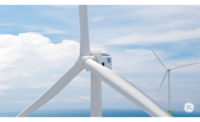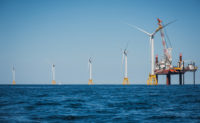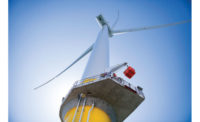Aimed for the first commercial deployment in the U.S. by 2021, the giant GE Haliade-X 12-MW offshore wind turbine has arrived in Boston for testing at the Massachusetts Clean Energy Center wind test facility.
To prepare for commercialization by 2021, the 107-meter blade will undergo a series of fatigue tests over the next several months to validate that it can withstand more than 25 years of operation at sea, says the center.
“The center will use bridge cranes to move the blade and servo-hydraulic actuators for the fatigue testing,” says a MassCEC spokesman.
GE Renewable Energy, Haliade's manufacturer, recently announced the company has been selected as the preferred turbine supplier by Danish developer Ørsted for planned East Coast offshore wind projects in New Jersey and Marylad, and by the Equinor-SSE joint venture for the 3.6-GW Dogger Bank wind farm project—claimed to be the world’s largest offshore when it completes.
GE Renewables says it has contracted the Haliade-X for nearly 5 GW of offshore wind project capacity.
These developments come as Massachusetts and other U.S. states have set ambitious offshore wind targets totaling nearly 20 GW, according to the University of Delaware Special Initiative on Offshore Wind, which projects a $70-billion supply chain associated with the new industry.
“This has really been a collaborative effort on the part of the company to be part of solving the challenges associated with the energy transition," said GE Chairman and CEO H. Lawrence Culp. "We think the Haliade-X is the right turbine at the right time as the offshore industry globally and particularly here in the U.S. is poised to take off."
GE's estimated $400-million Haliade-X investment will help reduce offshore wind’s cost of energy—with each turbine capable of powering more than 5,000 U.S. homes, MassCEC says.
The global offshore wind market is projected to grow to 120GW by 2030, according to the Global Wind Energy Council.
Dedicated exclusively to wind blade testing, the center's wind testing facility offers a full suite of certification tests for turbine blade sections up to 90 meters in length, in addition to wind turbine blade testing and prototype development methodologies tor the next generation of offshore and land-based wind turbine technologies.
Since 2011, the facility has run 35 distinct blade testing programs involving hundreds of individual blade tests as a globally certified renewable energy testing lab for wind turbine blades.
It the only location in North America to offer blade testing and certification at this size and scale, says Massachusetts Energy and Environmental Affairs Secretary Kathleen Theoharides.
The University of Maine Advanced Structures and Composites Center also has extensive experience testing wind blade components and substructures.
It offers a full suite of certification tests for turbine blades and blade sections shorter than 70 m in length and has successfully tested full-scale blades for several original equipment manufacturers, says John Arimond, business development manager for the University of Maine Advanced Structures and Composites Center.
Similar to MassCEC, the UMaine composites center also offers wind-turbine blade testing and prototype development for offshore and land-based wind turbine technologies. However, the UMaine faaciity which also offers structural testing capabilities beyond wind blades, but it has only one test stand with a 70-m-length capacity, compared to three-test-stands with a 90-m capacity at MassCEC, he says.
Both centers were established in 2010 with U.S. Energy Dept. funding.
On Oct. 22, DOE awarded several wind energy research grants, including one for equipment upgrades at the MassCEC center to enable structural testing of 85 to 120-m long blades.
“Blades longer than about 60 meters cannot be transported in one piece by truck to most wind farm destinations,” which has led to the design and manufacture of blades longer than 60 m in two pieces, Arimond says.
“The aerodynamic performance of wind blades (power performance and noise) is critically affected by design and manufacturing details near the tip,” he says, with structural integrity generally most critical within 40 m to 50 m of the blade root.
“Wind blades occasionally fail catastrophically in end use,” says Arimond, with such failures typically initiating within the half of the blade length toward the root.
“Test methods and certification requirements for two-piece blades continue to evolve,” he says.
Separately, Maine regulators approved on Nov. 6 a 20-year power-purchase deal for Central Maine Power to buy supply produced by an experimental floating offshore wind power project built by the center and its partner, the Maine Aqua Ventus consortium, that could become the first floating wind turbine in the U.S. to commercially deploy.






Post a comment to this article
Report Abusive Comment